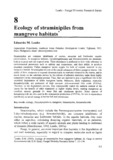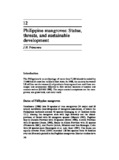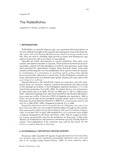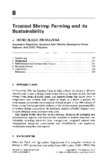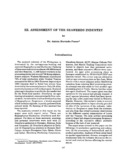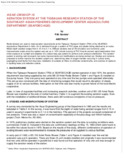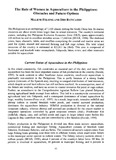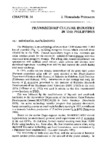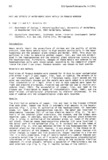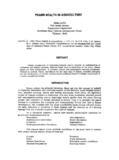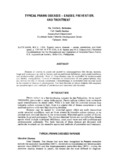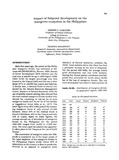Books and Book Chapters: Recent submissions
101-120 / 120
-
Series: Fungal Diversity Research Series; 7
Ecology of straminipiles from mangrove habitats
(Fungal Diversity Press, 2002)Straminipiles are common inhabitants of marine, estuarine and freshwater aquatic environments. In mangrove habitats, halophytophthorans and thraustochytrids are abundant, both in tropical and sub-tropical areas. Their ... -
Philippine mangroves: status, threats and sustainable development
(United Nations University Press, 2004)The status of the Philippine mangroves is examined, the functions of mangrove areas are highlighted, the threats to mangrove resources are identified, and the prospects for sustainable use are discussed. The Philippines ... -
Milkfish, Chanos chanos
(CAB International Publishing, 2002)This chapter reviews information on nutrient requirements, feeds and feeding practices of milkfish. -
Aquaculture
(Elsevier, 2001)Aquaculture, the aquatic counterpart of agriculture, has grown rapidly in recent decades to become one of the most important means of obtaining food from the sea. Impacts of aquaculture on biodiversity arise from the ... -
The rabbitfishes
(Elsevier, 1995) -
Mud crab culture
(John Wiley and Sons, 2000)Mud crabs are one of the most widely sought crustacean species that inhabit the estuarine areas and tidal rivers and creeks of the Asian and Indo-Pacific regions. Hailed as "food for the gods," the mud crab is recognized ... -
Tropical shrimp farming and its sustainability
(Academic Press, 1998)In December 1996, the Supreme Court of India ordered the closure of all semi-intensive and intensive shrimp farms within 500 m of the high tide line, banned shrimp farms from all public lands, and required farms that closed ... -
Historical and current trends in milkfish farming in the Philippines
(Academic Press, 1998)This chapter focuses on the historical and current practices of milkfish farming in the Philippines. The Philippines ranks among the top 12 largest fish producers in the world and the milkfish, Chanos chanos, is the official ... -
Order Gonorynchiformes: Chanidae: Milkfish
(Food and Agriculture Organization of the United Nations, 1999) -
Assessment of the seaweeds industry
(Department of Science and Technology and United Nations Development Programme, 1995) -
Aeration system at the Tigbauan Research Station of the Southeast Asian Fisheries Development Center, Aquaculture Department (SEAFDEC/AQD)
(ASEAN/UNDP/FAO Regional Small Scale Coastal Fisheries Development Project, 1986)Roots blowers are used to meet aeration requirements at the Tigbauan Research Station (TRS) of the SEAFDEC Aquaculture Department in Iloilo. Air is delivered through a system of PVC pipes and plastic tubing attached to air ... -
The role of women in aquaculture in the Philippines: obstacles and future options
(Gender and Development Studies, School of Environment Resources and Development, Asian Institute of Technology, 2001) -
Series: Developments in Aquaculture and Fisheries Science; 23
Prawn/shrimp culture industry in the Philippines
(Elsevier, 1992)The Philippines is an archipelago of more than 7,100 islands with 17,460 km of coastline, including mangrove forests which covered about 450,000 ha in the 1920s. Coastal aquaculture began a few centuries ago when earthen ... -
Fate and effects of water-borne heavy metals in Penaeus monodon
(European Aquaculture Society, 1991)Heavy metals impair the aquaculture of shrimps and the quality of shrimp products. Some heavy metals occur in high amounts particularly in the hepatopancreas and the antennal gland (Gibson and Barker, 1979). This study was ... -
Selection, transport and acclimation of prawn fry
(U.P. Aquaculture Society, 1988)The most important criterion among many used by operators for choosing poostlarvae to stock in ponvds, is the stage of development. THe stages considered suitable for stocking (about PL20) can be identified by ... -
Prawn health in aquaculture
(U.P. Aquaculture Society, 1988)Disease management of intensively-cultured prawns requires an understanding of physiology and disease causation. Maladies result from an interaction of the prawn, disease agents and their environment. In intensive culture, ... -
Typical prawn diseases - causes, prevention, and treatment
(U.P. Aquaculture Society, 1988)Diseases of prawn in ponds are caused by microorganisn like viruses, bacteria fungi and protozoans as well as factors such as nutritional deficiency, poor pond conditions and environmental pollutants. Most of these may be ... -
Fry and fingerling collection and handling
(The Oceanic Institute, 1986)A review is made of methods and practices of collection, storage, transport and acclimation of milkfish (Chanos chanos ) fry and fingerlings in various countries. Factors affecting catch and survival are examined. -
Nutrition and feeds
(Oceanic Institute, 1986)Milkfish culture is gradually shifting from the traditional extensive aquaculture system, where in the fish depends mainly on natural food for growth, to semi=intensive or intensive culture systems in which additional ... -
Impact of fishpond management on the mangrove ecosystem in the Philippines
(Natural Resources Management Center and National Mangrove Committee, Ministry of Natural Resources, 1986)Fishpond development in the Philippines is discussed, examining resulting impacts on the mangrove ecosystems. Socio-economical implications and management measures are also considered.

